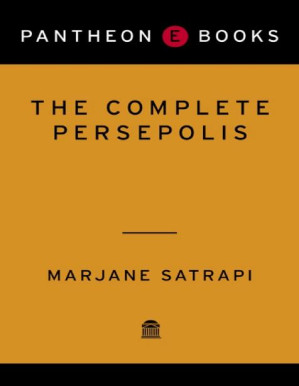Political upheaval transforms ordinary childhood into extraordinary survival
Marji's innocent world of pop music and Western jeans collides with mandatory veils and revolutionary guards.

Book summary
by Marjane Satrapi
A graphic memoir of growing up during Iran's political upheaval
Girlhood memoir during Iran's Islamic Revolution
Topics
Read this graphic novel as both personal memoir and historical document. Use Readever to pause after key visual sequences and reflect on how Satrapi uses simple black-and-white art to convey complex emotions. Highlight moments where political events intersect with personal experience and create timeline notes to track Marji's development. Use Readever's AI to provide cultural context for Iranian traditions and help you understand the visual storytelling techniques.
Things to know before reading
Persepolis is Marjane Satrapi's acclaimed graphic memoir about her childhood in Tehran during the Islamic Revolution. Through stark black-and-white illustrations, she chronicles the political turmoil, cultural shifts, and personal transformations that shaped her coming of age—from a rebellious child questioning authority to a young woman navigating exile and self-discovery.
*Persepolis* reveals how political revolution reshapes childhood, family, and the very meaning of home.
Marji's innocent world of pop music and Western jeans collides with mandatory veils and revolutionary guards.
Marji's educated, Westernized parents risk everything to protect her spirit while teaching her to survive.
Marji's European education gives her freedom but also alienates her from both Iranian and Western identities.
Ready to continue? Launch the Readever reader and keep turning pages without paying a cent.
This summary helps you grasp how political upheaval transforms personal identity. You'll learn how to maintain individuality amid cultural pressure, find humor in hardship, and recognize the universal struggle between tradition and modernity.
Key idea 1
Marji's innocent world of pop music and Western jeans collides with mandatory veils and revolutionary guards.
Satrapi masterfully contrasts the normalcy of childhood—playing with friends, idolizing pop stars—with the sudden imposition of religious fundamentalism. The revolution forces Marji to navigate two worlds: the private space of her progressive family and the public sphere of enforced conformity. This tension shows how political change becomes personal when it dictates what you wear, what you study, and who you can be.
Remember
Key idea 2
Marji's educated, Westernized parents risk everything to protect her spirit while teaching her to survive.
The Satrapi family embodies the complexity of Iran's educated middle class—patriotic yet critical, traditional yet modern. Marji's parents smuggle forbidden jeans and music, teach her about political prisoners, and eventually send her to Europe for safety. Their decisions reveal the heartbreaking calculus families make during political instability: how much freedom to allow, when to resist, and when to flee.
Remember
Key idea 3
Marji's European education gives her freedom but also alienates her from both Iranian and Western identities.
Sent to Austria for safety, Marji discovers that freedom comes with its own costs. She struggles with loneliness, cultural misunderstanding, and the pressure to assimilate. Her European experience reveals how exile creates a permanent sense of displacement—you're never fully at home in either culture. This section explores the immigrant's eternal negotiation between preserving heritage and embracing new opportunities.
Remember
Persepolis is a graphic memoir that chronicles Marjane Satrapi's childhood and early adulthood in Iran during and after the Islamic Revolution. The story begins in 1979 when Marji is ten years old, witnessing the overthrow of the Shah and the establishment of the Islamic Republic. Through her innocent but perceptive eyes, we see how political ideology transforms daily life—schools become ideological battlegrounds, Western influences become forbidden, and family secrets become dangerous.
The narrative follows Marji's rebellious spirit as she navigates mandatory veiling, political indoctrination, and the Iran-Iraq War. When the political climate becomes too dangerous, her parents send her to Austria, where she faces different challenges of cultural alienation and identity crisis. The memoir powerfully demonstrates how large-scale political events shape individual lives, particularly those of women and children.
Open Readever's reader to highlight passages, ask the AI companion questions, and keep exploring without paying a cent.
Satrapi's black-and-white illustrations create an immediate emotional connection, making complex political history accessible and deeply personal. The graphic novel format allows her to convey both the external realities of revolution and the internal landscape of a child's confusion, fear, and resilience. Her simple yet expressive art style captures the absurdity of ideological extremism while preserving the humanity of all characters.
Critical Reception: Persepolis won the Angoulême International Comics Festival Prize for First Comic Book in 2001, was named one of Time magazine's Best Comics of 2003, and was adapted into an Academy Award-nominated animated film in 2007. The New York Times called it "a brilliant and unusual graphic memoir" that "makes us see how political upheaval can shape and distort individual lives."
Readers interested in understanding the human impact of political revolution
Graphic novel enthusiasts seeking powerful, emotionally resonant storytelling
Educators teaching about Middle Eastern history, women's rights, or immigration
Anyone navigating cultural identity between tradition and modernity
Young adults exploring questions of identity, rebellion, and belonging
Marjane Satrapi is a French-Iranian graphic novelist, cartoonist, illustrator, and film director. Born in 1969 in Rasht, Iran, she grew up in Tehran during the Islamic Revolution. After being sent to Vienna for safety, she studied visual communication in Strasbourg, France, where she began her career as an illustrator and graphic novelist.
Persepolis, originally published in four volumes in France, became an international bestseller and established Satrapi as a major voice in graphic literature. Her other works include Embroideries, Chicken with Plums, and The Sigh. In 2007, she co-directed the animated film adaptation of Persepolis, which won the Jury Prize at Cannes and was nominated for an Academy Award for Best Animated Feature.
Satrapi's work consistently explores themes of identity, exile, and the intersection of Eastern and Western cultures. She currently lives and works in Paris, continuing to create graphic novels and films that bridge cultural divides.
Build your personalized reading stack
Download full-length ePubs in one click with personal cloud storage.
Blend AI-guided insights with tactile note-taking to accelerate reflection.
Follow curated reading journeys tailored to your goals and time budget.
Sync highlights across devices so lessons stick beyond the page.
Sign in to Readever to keep reading with AI guidance, instant summaries, and synced notes.
Persepolis demonstrates that political revolutions are never abstract—they happen in living rooms, classrooms, and the hearts of children. Satrapi's memoir reminds us that while ideologies may change borders and laws, the human spirit persists in its search for freedom, identity, and connection. Her story offers a powerful testament to resilience, the complexity of cultural identity, and the universal need to belong somewhere—even if that somewhere exists only in memory.
Add detailed content, analysis, and insights about Persepolis here.
This extended outline can capture critical concepts, practical applications, and deeper understanding from the book. Use this space to provide comprehensive notes that enhance the reading experience.

Dale Carnegie
Classic guide to building relationships and improving communication skills

Cal Newport
Rules for focused success in a distracted world through sustained attention

Julia Cameron
A 12-week program to recover creativity through morning pages and artist dates
Start reading Persepolis for free and unlock personalized book journeys with Readever.